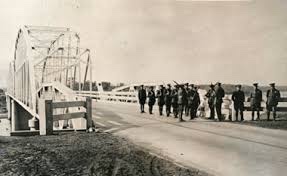by Edward Southerland
A half a mile downriver from the present US 75 bridge crossing the Red River north of Denison, Colbert’s Ferry used to transport people, teams and wagons, and goods across the muddy waters that divided Texas from the Nations, as the Indian Territory was called. The ferry was named for a Chickasaw, Benjamin Franklin Colbert, who had hired Joseph B. Earhart to organize the service. This was in 1849, and Colbert’s Ferry was the second business to have worked that part of the river. Another Chickasaw, Joseph Mitchell, had been in the ferry business from 1842 until his death in 1847.
From 1858 until 1861, the ferry was the crossing point for the Butterfield Overland Mail stages running between St. Louis and San Francisco, but after the Civil War the newer forms of transportation demanded a bridge. The ferry wouldn’t do when the Missouri, Kansas and Texas Railway, the Katy, pushed its tracks into Texas in 1872 and into the newly minted town of Denison. The iron rails that first tied Texas to the north did so over the Indian Bridge, a wooden structure built a half-mile upriver from Colbert’s ferry operation.

Business on the ferry dwindled, and in July 1873, Colbert opened his own toll bridge for cross-river traffic. It lasted eleven months, until one of the periodic floods that roared down the river destroyed both it and the railroad bridge. While the Katy rebuilt its trestle, Colbert hauled out the ferry equipment and began trips back and forth across the river again. The ferry was the only way to cross for the next eighteen years until the Red River Bridge Company of Denison obtained Colbert’s bridge concession, built a new bridge in 1892, and again the ferry service ended.

As more automobiles took to the roads following the Great War, Denison residents begin to clamor for a free bridge across the river. Hal Collins, a Ford automobile dealer in Denison, was one of the first to publicly raise the idea. State Senator Jake J. Loy guided a bill through the Texas legislature authorizing the joint construction of the bridge with the state of Oklahoma and allowing the Texas Highway Department to negotiate with the toll bridge owners in the matter of compensation for the loss of their business. Construction began in May 1930. Eleven months later the bridge was finished and ready for use. Well, almost.


The flamboyant Sooner governor responded with the Oklahoma National Guard. On the July 17, Murray directed his highway crews to block the Oklahoma approaches to the toll bridge and direct traffic to the bridge at Preston, 30 miles away. The Red River at Denison now had two bridges, but no way to cross. The Rangers faced the guardsmen over the disputed bridges for more than a week.

Texas Rangers blocking the south end of the Red River Bridge.
On July 20 and 21, mass meetings were held in Denison and Sherman demanding the opening of the bridge. Two days later, the Texas legislature passed a bill granting the toll bridge company the right to sue the state to recover its losses the under the terms of the buy-out agreement and both parties returned to the federal court in Houston seeking dissolution of the injunction. The court complied on July 25, and the free bridge was opened once again.
Meanwhile, on July 24, acting on a petition from the bridge company, a federal court in Muskogee, Oklahoma, had enjoined Governor Murray from continuing his destruction of the Oklahoma approaches to their bridge. Hours before this injunction took affect, Murray declared a narrow strip of his state that covering the approaches to both bridges, under martial law.
Declaring that as commander of the National Guard he was not subject to the Muskogee injunction, Murray marched on the bridge, pistol at his side, to make whatever point, if any, he was trying to make. The entire exercise was moot, since the bridge was now open, the bridge company had a way to get the rest of its money and nobody cared anymore. Not one to stay out of an available spotlight for long, Murray extend his martial law zone to the edge of the Texas line on July 27, and sent guardsmen to the south end of the bridge. Texas cried “Invasion!”

On August 6, 1931, the Houston court permanently dissolved the Texas injunction, and the Oklahoma guardsmen were pulled off the river watch and sent to enforce martial law in the Oklahoma oil fields where new trouble was brewing. The old toll bridge, now owned by the state of Texas, served as a southbound span for US 75 traffic for a number of years and even longer as an adjunct to the main river bridge. Even as the old bridge grew more hazardous, traffic continued to use it as shorter route to the stores and businesses in downtown Denison.
The bridge was blocked for good in 1958, when a ten-foot mound of earth was bulldozed in front of the Texas approach. On May 31, 1961 the old toll bridge caught fire. The collapsing wooden deck snapped a four-inch natural gas line and flames shot high into the night sky as the section crossing the river wilted and fell into the water. The old free bridge was demolished in 1995 following the opening of new spans carrying US 75 across the Red River.